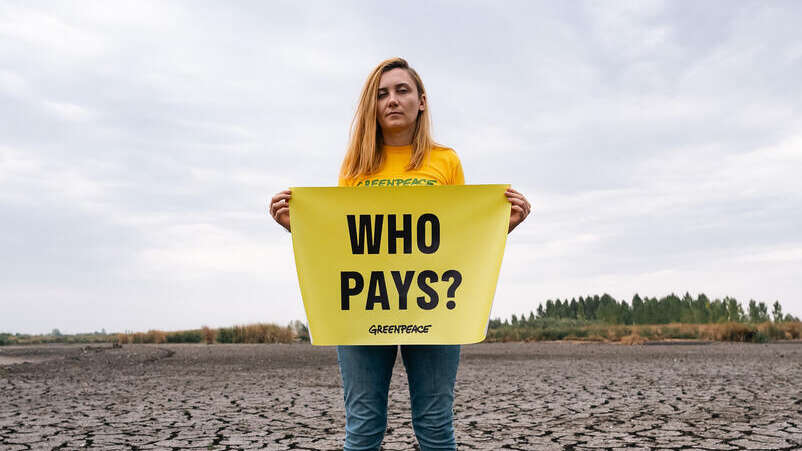Brunsbüttel, Germany – Onboard floating devices, 22 Greenpeace activists from Germany are protesting the arrival of the tanker Celsius Gandhinagar loaded with liquefied fossil gas (LNG) from the United States, entering the port of Brunsbüttel. Activists have attached a 100-meter-long banner saying “Gas destroys – Stop fossil gas” to the floating gas terminal and set up a floating protest camp. The tanker left from Calcasieu Pass LNG Terminal in Louisiana, and is the first one traveling from the US to Germany since the US election.
European Union (EU) Commission President Ursula von der Leyen suggested in a call with president-elect Trump that Europe should buy even more American fossil gas.
“Everyone wants fair energy prices and energy security but this won’t happen by becoming dependent on yet another fossil gas-providing country. Switching from Putin’s gas to Trump gas will perpetuate Europe’s dependence on gas imports. Keeping us locked into a fossil fuelled energy system. The EU must speed up the green energy transition and ban new fossil fuel infrastructure projects across Europe. It is a matter of safety and a matter of justice for present and future generations”, says Mira Jaeger, energy expert from Greenpeace Germany.
New gas deals with the US threaten American’s health and the climate
A recent study showed that US liquified gas can be more harmful for the climate than coal.[1] More than three quarters (78%) of US gas comes from shale formations. US liquefied gas mainly comes from fracking which is posing a threat to communities who live nearby extraction and processing sites.[2][3] Fracking has already been banned in several European countries over safety and health concerns. In Germany, where fracking has been banned since 2017, hypocritically 84% of liquefied natural gas imports come from the US.[4]
Despite US President Biden’s temporary moratorium on new infrastructure projects for liquefied gas exports, the US remains responsible for a third of new oil and gas extraction planned by 2050.[5] It is the largest exporter of liquefied gas to Europe.[6] President-elect Donald Trump plans to lift this moratorium on his first day in office. In a bid to avert Trump’s threat of introducing import tariffs on EU goods, EU Commission President Ursula von der Leyen reportedly proposed to increase imports of US liquefied gas to the EU in a call with president-elect Trump.
Kelcy Warren, co-founder, largest shareholder, and Executive Chairman of Energy Transfer LP (ET), one of the largest oil and gas pipeline companies in the US and owner of a pending LNG export facility in Louisiana affected by the Biden moratorium, provided significant financial support to the Trump Campaign. Energy Transfer is suing Greenpeace International and Greenpeace in the US in a Strategic Lawsuit Against Public Participation (SLAPP) lawsuit related to the protests at Standing Rock. If we lose, Greenpeace US could face financial ruin.
John Noël, Deputy Climate Program Director at Greenpeace USA, said: “Runaway LNG exports jack up prices for consumers, fueling the cost-of-living crisis that’s crushing everyday people. Approving new LNG exports terminals at this moment in history enriches no one except for fossil fuel CEOs and the billionaire class they serve. Thankfully, the resistance to increased LNG exports is international. As the incoming US administration promises to force more drilling and exports, it’s imperative the international community stops buying Trump LNG.”
The EU must end the dependence on destructive fossil fuels
In order to replace Russian gas imports, new liquefied gas import infrastructure has been booming across Europe since 2022. Although many of the planned import terminal projects are still pending, the existing European facilities are already running at only about half capacity. A recent study by the Institute for Energy Economics and Financial Analysis (IEEFA) predicts that up to two thirds of European liquefied gas import terminals could remain unused by 2030.[7] Yet fossil fuel companies are spending billions on new fossil fuel infrastructure, much of it supported by taxpayers’ money.[8]
Greenpeace is demanding that the EU and national governments turn off the tap, by banning all new fossil fuel infrastructure projects, phasing out fossil gas, and investing in decreasing gas demand, expanding renewables and cutting energy waste.
ENDS
Notes:
Photos and videos are available from the Greenpeace Media Library.
[1] Liquefied natural gas carbon footprint is worse than coal | Cornell Chronicle
[2] Frequently Asked Questions (FAQs) – U.S. Energy Information Administration (EIA)
[3] US fracking boom could tip world to edge of climate disaster | Oil | The Guardian
[4] Jahresbericht Energieversorgung 2023 | BDEW
[6] Where does the EU’s gas come from? | European Council Council of the European Union
[7] European LNG import terminals are used less as demand drops | IEEFA
[8] EU climate fund bankrolling dirty energy expansion | Bankwatch
Contacts:
Manon Laudy, Press Officer, Fossil-Free Future Campaign, Greenpeace, +336 49 15 69 83, [email protected]
Greenpeace International Press Desk, +31 (0)20 718 2470 (available 24 hours), [email protected]



